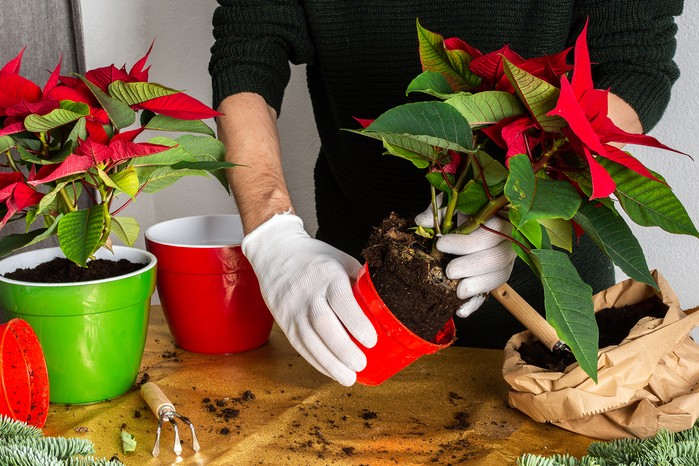The poinsettia — with its striking red, white, or pink bracts — is the ultimate symbol of the holiday season. But did you know that this festive favorite can thrive long after Christmas with the right care? Whether you’re keeping it as a cheerful winter houseplant or trying to get it to rebloom next year, learning how to take care of a poinsettia plant is easier (and more rewarding) than you might think.Let’s dive into unbelievable care hacks, expert tips, and step-by-step guidance to help your poinsettia stay lush, colorful, and healthy all year round! 🌿🎄 Why Poinsettias Are So SpecialNative to Mexico and Central America, poinsettias (Euphorbia pulcherrima) were prized by the Aztecs long before becoming Christmas icons. Their vibrant red “petals” aren’t actually flowers — they’re bracts, or modified leaves — with the real blooms being the tiny yellow buds in the center.Today, poinsettias come in dozens of colors, from creamy white to candy pink and even speckled varieties. They’re stunning, low-maintenance, and full of holiday cheer — if you know how to care for them properly!🌞 Step 1: Find the Perfect SpotLight is the secret to a thriving poinsettia!🌿 Light RequirementsBright, indirect sunlight is best. Place your plant near a sunny window but keep it out of harsh direct rays.In darker months, rotate the plant every few days to ensure even light exposure.🌺 Pro Tip: Poinsettias love consistency — avoid moving them too often or placing them near cold drafts or heaters.💧 Step 2: Water Like a ProOverwatering is one of the most common mistakes in poinsettia care.🌼 Watering RulesCheck the soil daily — when the top inch feels dry, it’s time to water.Water thoroughly until it drains from the bottom of the pot, then discard any excess water.Never let your poinsettia sit in standing water!💦 Hack: Use room-temperature water. Cold water can shock the roots and cause leaves to drop.🌡️ Step 3: Keep It Warm and CozyPoinsettias thrive in temperatures between 65°F and 75°F (18°C to 24°C).❄️ Avoid:Cold windowsillsDrafty doorwaysHeat vents or fireplacesSudden temperature changes can cause leaves to curl or fall off.🌸 Winter Tip: If you’re bringing your poinsettia home during chilly weather, wrap it loosely in paper to protect it from the cold.🌿 Step 4: Feed for Healthy GrowthOnce the blooming season ends (around February to March), it’s time to help your poinsettia regain strength.Start feeding it every 2–3 weeks with a balanced, water-soluble fertilizer (like 10-10-10).Stop fertilizing in late fall before the bracts begin to color again.🌱 Bonus Tip: Fertilizing keeps your poinsettia green, full, and ready for its next blooming cycle!🌸 Step 5: Prune and Repot After the HolidaysAfter the colorful bracts fade, don’t toss your poinsettia! With pruning and patience, it can bloom again.✂️ How to Prune:In March or early April, cut the plant back to about 6 inches tall.Keep it in a sunny spot and water as usual.New shoots will begin to grow within weeks.🪴 When to Repot:Repot in May or June using fresh, well-draining potting mix.Choose a slightly larger pot (1–2 inches wider) to encourage healthy root growth.🌿 Soil Tip: Use a mix that drains well — like cactus or houseplant soil — to avoid soggy roots.🌞 Step 6: Encourage Re-Blooming (The Secret Trick!)Here’s where the real poinsettia magic happens! If you want those beautiful red (or pink or white) bracts to reappear in time for the holidays, follow this light-control method starting in September.🌑 The Darkness RoutineFor 8–10 weeks before Christmas:Keep your plant in complete darkness for 14–16 hours each night (e.g., cover it with a box or place it in a dark closet).During the day, return it to bright, indirect sunlight.This mimics the natural light changes of winter, triggering the plant to produce colorful bracts again.🎁 Pro Tip: Be consistent — even small amounts of stray light can disrupt the blooming cycle!🌺 Step 7: Keep Pests AwayWhile poinsettias are fairly hardy, they can sometimes attract pests like whiteflies, aphids, or fungus gnats.🪲 Natural Pest Solutions:Wipe leaves gently with a mix of water and mild dish soap.Use neem oil spray for organic pest control.Ensure good airflow and avoid overwatering to prevent mold or fungus.🌸 Leaf Care Hack: Dust the leaves occasionally with a damp cloth to keep them glossy and healthy.💚 Common Poinsettia Problems (and Easy Fixes!)Problem Likely Cause Quick FixYellow leaves Overwatering Let soil dry out before watering againLeaf drop Drafts or cold air Move to a warmer, stable spotWilted bracts Too much sun or dryness Provide filtered light and mist leaves lightlyNo new blooms Inconsistent darkness Stick to strict 14-hour dark cycles🌼 Unbelievable Poinsettia Care HacksWant your poinsettia to look like a florist’s display? Try these simple hacks:Mist lightly: Poinsettias love humidity — a gentle mist every few days prevents leaf drop.Rotate weekly: Ensures even growth and prevents leaning.Add mulch or moss: Helps retain soil moisture and looks beautiful in decorative pots.Pair with evergreens: Display poinsettias alongside pine or holly for a stunning seasonal arrangement.Use LED fairy lights: A soft glow around the pot enhances the plant’s holiday charm without overheating it.🌹 Fun Facts About PoinsettiasThe poinsettia is named after Joel Poinsett, the first U.S. ambassador to Mexico, who introduced the plant to the U.S. in the 1820s.The red parts aren’t flowers — they’re leaves that turn color under specific light conditions.Contrary to popular myth, poinsettias are not deadly to pets or humans, though they can cause mild irritation if ingested.🌸 Final Thoughts: Unbelievable How to Take Care of a Poinsettia Plant!Caring for a poinsettia might seem like a seasonal affair, but with the right steps, your plant can thrive for years — reblooming every holiday season with brilliant color. Remember: plenty of indirect sunlight, careful watering, consistent warmth, and a little patience are all it takes.So this year, don’t just enjoy your poinsettia for a few weeks — nurture it, watch it flourish, and let it brighten your home all year long! 🌺✨

